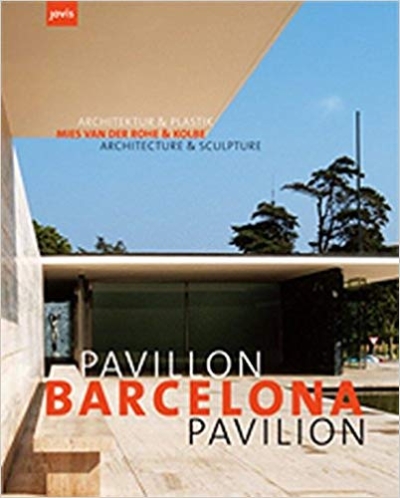
Barcelona Pavillon /Barcelona Pavilion: Mies van der Rohe und Kolbe Architektur und Plastik /Architecture and Schulpture: Miles
Für die Weltausstellung in Barcelona 1929 entwarf Ludwig Mies van der Rohe den deutschen Ausstellungspavillon, der auch heute noch Inbegriff des idealen „fließenden“ Raumes ist: Wenige Wandscheiben aus blank poliertem grünem Marmor und goldbraunem Onyx sowie ein paar verchromte Stahlstützen unter einer tief liegenden Dachplatte scheinen diese weniger zu stützen als vielmehr am Abheben zu hindern – eine Komposition von höchster Perfektion. Das Lichtspiel auf den glatten Materialoberflächen lässt die innen liegenden Bereiche mit zwei im Freien angelegten Wasserbecken zu einem einzigen Raum verschmelzen. Als kongeniale Verbindung zwischen Innen und Außen reckt sich an der Seite eines dieser Becken die Frauengestalt
„Morgen“ dem Besucher entgegen – die von Georg Kolbe entworfene Skulptur, laut Kolbe: „Resultat: beste Ergänzung“.Dass Architektur und Plastik nicht ohne einander gedacht werden können, macht dieses Buch deutlich. Belegt mit zahlreichen historischen, aber auch aktuellen Aufnahmen, wird das Verhältnis
der beiden Künste erläutert. Dabei werden Georg Kolbes Arbeiten für Walter Gropius, Hans Poelzig oder Bruno Taut ebenso vorgestellt wie die Zusammenarbeit von Mies van der Rohe mit Künstlern wie Wilhelm Lehmbruck oder Aristide Maillol. Ein Standardwerk über den Barcelona-Pavillon, ein Meilenstein der deutschen Architekturgeschichte.
Ludwig Mies van der Rohe designed the German exhibition pavilion for the 1929 International Exhibition in Barcelona. Today, the German Pavilion is still the epitome of the ideal of “flowing” space: minimal wall partitions made of smoothly polished green marble and goldenbrown onyx; and beneath a low-lying roof panel, a few chrome steel supports seem less to hold it up, than to prevent its lift-off―a composition of the utmost perfection. The light-play on the smooth material surfaces allows the areas situated in the interior to
merge into a single space with two outdoor pools. Alongside one of these pools, as a congenial connection of inside and outside, a female figure called “Morgen” (“Morning”) stretches
towards the visitor―it is the sculpture designed by Georg Kolbe, who said: “Result: best completion”. This book clearly demonstrates that architecture and sculpture cannot be conceived without
each other. The relationship of these arts is explained and documented by numerous historical and also contemporary photographs. Georg Kolbe’s works for Walter Gropius, Hans Poelzig and Bruno Taut are introduced as well as Mies van der Rohe’s collaboration with artists such as Wilhelm Lehmbruck and Aristide Maillol. This book is the most comprehensive work about the
Barcelona Pavilion, a milestone in German architectural history.

































































































